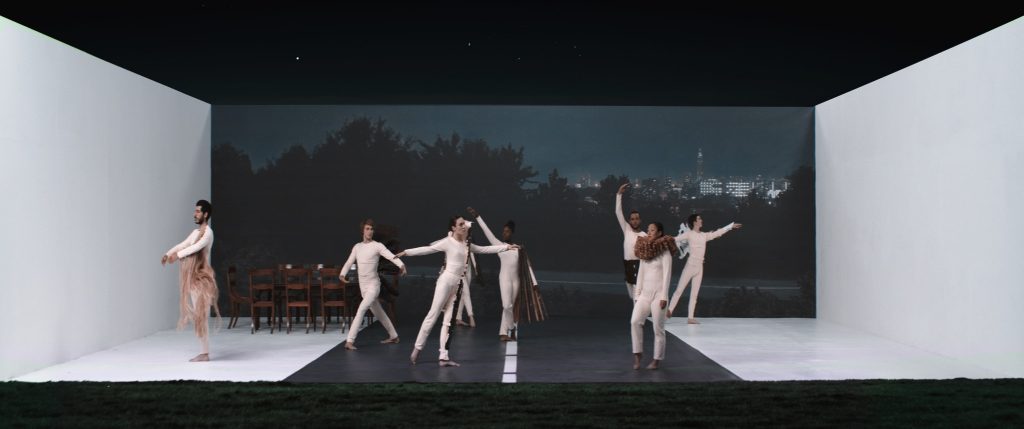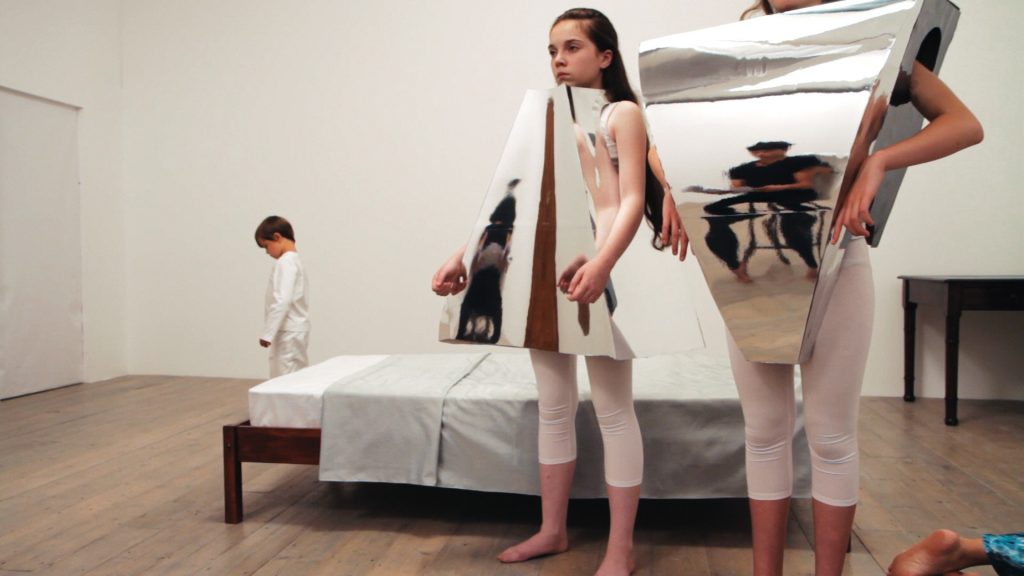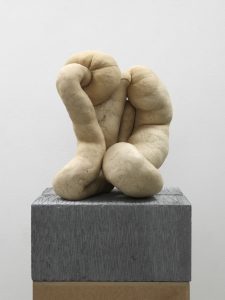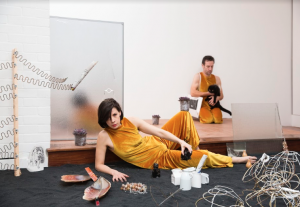
Grace Schwindt, Only a Free Individual Can Create a Free Society, 2014
London based artist Grace Schwindt is known for working with film, live performance and sculpture, often using theatrical sets and props for performances. In her Block Universe work, ‘Undead and Other Tales’, a singer performs a work based on an opera by Geatano Donizetti. This sonic work moves between opera and maritime sounds. Sung by Lisa Cassidy, the composition aims to explore the cultural traditions of depicting instability.
I interviewed Grace Schwindt to find out more.
The work your presents uses opera, specifically Gaetano Donizetti’s 19th-century work Lucia di Lammermoor. Why are you attracted to opera and this piece in particular?
I am actually more attracted to opera singers than I am to opera. I can work with them in a similar way I work with dancers. It allows me to look at and deconstruct the voice in a lot of detail. I like doing that while at the same time being directly connected to its loaded history. However, for me, it is not so much about deconstructing opera than deconstructing the voice, especially the voice in relation to language.
After I completed the film ‘Only a Free Individual Can Create a Free Society’, I wanted to focus on the voice and on sound. My starting point is a negotiation with various conventions of looking, looking at each other and also looking at different cultures. I guess from living and having grown up in a society where everyone is required to fit into rather narrow categories and where silence towards anything and anyone that is not the same seems to take over the code for political correctness, the opposite of being in touch with those who are not the same. Distorted ideas of tolerance and acceptance seem to dominate and produce exclusion and violence. I experience this as a very violent attitude and consequence of having to understand everything and everyone immediately.
So when I make a representation, I start firstly with stripping each element of its conventions and superimposed values, trying to look at it as material, as a thing in itself, for example a movement, walking, a word or a sound. I don’t aim to reach neutrality, and I don’t think it is possible. It comes from a refusal to represent something that I experience as violent, as I feel cultural constructions such as gender in a capitalist society can be. Similarly, with opera singers, I aim to look at the voice as a stripped down element that subsequently very quickly becomes loaded with associations, but, this time, with a logic that is not necessarily linear and that can escape immediate judgment according to conventional existing orders.
The reason I used Donizetti’s Lucia di Lammermoor is because it looks at one construction that I am dealing with in my work: the history of representation of women and the interpretation of ways to maintain conventions of power relationships, for example the insistence of understanding her disobedience as mad or hysteric.
The singer will use sounds that relate to maritime traditions. In both history and myth, the voice and maritime activities are linked. Can you explain why you chose to create a maritime connection in your work?
This work is part of a larger project that started with research about the Northern Sea Route, which, with the melting of the Ice, is increasingly becoming a key route for oil and gas, several projects have developed from this. I interviewed various people in the Shetland Islands, which have the largest oil port in the UK and, whilst doing that, I learned a lot about the fishing industry and looked into the history of it. It is full of rituals that aim to prevent and exorcise death, connecting to religious and superstitious beliefs. I am interested in how fishermen have dealt with the likelihood of their own death and how closely this fear is connected to family and love. For instance, on the Aran Islands, each family has a unique pattern that they use for the jumpers the fishermen wear, so their bodies can be identified should they drown and be brought back to their families.
I found a lighthouse in Shetland that I used as a location to make a sound work with three opera singers which I will later use to shoot a film. This lighthouse is home to a birdwatcher whose job it is to check birds that have been washed ashore for oil stains. He has a very specific relationship with the birds, taking a scientific approach when observing them while also being very aware of their fragility and caring for them with much love. Through his story, I was able to look into the fragility of the body in relation to a wider capitalistic reality. I developed the sound at the lighthouse with the singers and, subsequently, further developed this research in Istanbul where I realized a work for the 14th Biennial, and then in Vigo, Spain, where I was invited by Marco – Museum of Contemporary Arts – to produce an exhibition. There, maritime rituals are very closely intertwined with religious and superstitious beliefs, and with the devastating effects that many oil spills have had on the territory over the years.
Opera is a great cultural tradition. That often gets portrayed as something that is only open to people of a high class. Is this why you chose to deconstruct it?
I like taking on loaded traditions and take them apart, like every other element in my work, like movement, for instance walking. For the sound work in Shetland I also looked into the history of pre-radio use of telephone lines to enable late 19th Century audiences to remotely listen to live concerts and operas from their homes or public listening points, this used to be connected to the idea of democratizing opera. From the lighthouse in Shetland the sound was then transmitted via a telephone line and via analogue and digital radio to various listening stations we set up in different galleries across the UK and available to listeners worldwide.
The performance will take place in a courtyard at the Royal Academy of Arts, another venue that belongs to cultural traditions. Was this a conscious choice?
I wanted to work in an outdoor space that is connected to a history of conventions of looking at cultural productions and different cultures in general. The Royal Academy Courtyard also allows me to create a more intimate viewing space for the stage on which a puppet acts as a puppeteer, keeping a figure barely alive, which could be read as being a part of the opera singer. The singer conversely can move freely around the courtyard in the open space, moving towards and away from the audience.
Lisa Cassidy will perform the work. What was the process of working with her like?
I worked with Lisa before, in Spain, when we produced ‘Madness and Other Tales’ at Marco – Museum of Contemporary Arts in Vigo. It has been wonderful working with her, she is very open to experiment and engage with my idea of experimentation. We spent some time going through the composition itself and the ideas for the improvisation parts, finding the right atmosphere and rhythm. In the case of Spain, we then worked with a conductor and an ensemble of musicians, which was a great experience.

Grace Schwindt, Tenant, 2012
Other than creating maritime connections, how else have you deconstructed the operatic work?
I first went through the opera score, taking out large parts of the lyrics, then finding many moments where to insert my compositions, what I called the 2 and 3-tone melodies. I also chose parts from the score that Lisa and the musicians then used for various improvisations. We worked with loops, repetition, reverse and extensions. The 3-tone melody, for example, was inspired by Carson McCullers’s book ‘The Heart Is a Lonely Hunter’. She was also a pianist and often refers to music in her writing to describe mood and atmosphere. At one moment she describes how a man spends a hot summer afternoon walking around town, rolling car wheels around and humming a 3-tone melody for ages, he goes on and on and on. I understood it as a sense of boredom, but also a sense of persistence through repetition to possibly reach a point of understanding the world in a slightly different way. The 2-tone melody and the extended notes are mainly used to transcend human quality and resemblance and to experiment with moving the voice away from language and, even, from the body.
What’s next for you after Block Universe? Is there anything upcoming that you can tell me about?
I am working on several projects at the moment. The two main ones are the film I am planning to shoot at the lighthouse in Shetland next year, and a performance for Performatik 2017 at the Kaai Studios in Brussels. They are the two larger projects from which others will again develop, such as a series of sculptures. I am also working on a project for an exhibition curated by Victor Wang in Havana in July this year, where I will work with a group of ‘Punto Cubano’ performers who use improvisational poetry set to music and which will look at presenting costumes as sculpture, image and clothing. Currently I am also in the process of making a new sculpture and a performance called ‘Magician’s Box’ that will be presented at ICIA in Bath next week.
Grace Schwindt’s work ‘Undead and Other Tales’ will be performed at 3pm this Sunday 5th June at Annenberg Courtyard, Burlington House, Royal Academy of the Arts. Free admission. For more info go here









